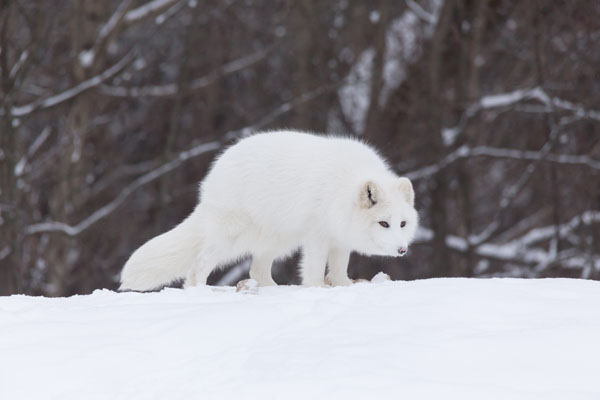How Animals in Alaska Survive Winter

Creatures native to Alaska – from the tiny wood frog to the lumbering muskox – have clever survival tools for getting through the long cold season. As we hunker down for the winter and break out the snowshoes, we’ve decided to share some ways our Alaska animals cope with the cold.
Grizzly bears
Seeing a grizzly is at the top of the list for many Alaska travelers, and late July presents a prime opportunity to see some pre-winter activity. During this time, bears enter a stage called hyperphagia, which is essentially a feeding frenzy. You can see bears gathering at rivers and streams chowing down on salmon, building up body stores for their winter hibernation. But beware: Bears are not completely inactive during winter. They give birth during the winter and raise cubs within their dens, and can attack if disturbed. They will emerge fully awake by May, depending on altitude, weather and location.
Wood frogs
Denali National Park’s only amphibian has become somewhat of an Internet legend because of its ability to endure freezing temperatures, making it appear to freeze solid and survive. The frog has a high freeze tolerance because of cryoprotectants in its system, allowing it to stop its heartbeat and circulation and freeze and thaw several times during a winter season. Way cool, literally.
Arctic ground squirrels
Like their amphibian neighbors, Arctic ground squirrels can lower their body temperatures below freezing – they drop to 27 degrees, lower than any other mammal in hibernation. Their fluids don’t actually freeze, however, and they rouse themselves and warm up every 20 days or so, possibly to recharge or clear out toxins. Squirrels prefer to hibernate alone, unlike hoary marmots, which prefer to have company.
Muskoxen
Alaska’s muskoxen are built to survive the long winters. These herbivores have a shaggy covering and develop a special shorter undercoat in the cold months, keeping them comfortable despite plunging temperatures. Their hooves are made to dig through snow so they can find roots and lichens to munch on. And they naturally stick together in herds to keep themselves safe from bears and predatory wolf packs.
Wolves
Wolf packs in Alaska stay active throughout the winter, sharing large meals primarily of moose, caribou or sheep. Wolf meals are about evenly split between fresh kills and meat scavenged from animals that died naturally. They’re tenacious: They will dig as deep as 10 feet into the snow to find these carcasses. But they aren’t all business during the season – like their tame canine counterparts, wolves love to run and play in the snow.
Moose
Moose, one of the targeted food sources of wolf packs, also continue roaming throughout the winters, foraging on small twigs and branches. They’re after the bark, which keeps them sustained, though not replete. Moose will lose about 25 percent of their body weight over the winter months – so like grizzly bears, they spend a good part of summer binging to get ready.
Arctic foxes
The striking Arctic fox is right at home in the winter months. Its thick, protective coat changes from brown to white with the season, providing camouflage to help keep it safe from predators and also to give it cover while hunting. Their paws are covered with the same heavy fur to allow them to walk on ice and snow. Their ears, legs and muzzle are short, helping it preserve heat. Those ears have super hearing, helping them to find little critters under the snow. Watch out, lemmings.
Willow ptarmigan
Alaska’s state bird also naturally changes appearance, transitioning in winter from a light brown to white. Its feathered feet protect it from icy groundcover. Like muskoxen, they tend to stick together in winter as there is safety in numbers. Like moose, they feed on twigs of their namesake dwarf willow, preferring the buds, leaves and seeds.
Caribou
What species is more winter-ready than the ones pictured pulling Santa’s sleigh? Caribou and reindeer are actually the same species. And they’re definitely built for snow. Their hooves are pliable, spreading to help support the caribou on snow. These herding animals keep moving, sometimes 50 miles in a day when migrating. In the winter, they hang out in boreal forests, also known as taiga.
Inspired by these hearty winter creatures? Book a sightseeing excursion or plan a stay in Denali to see this wildlife in action.
Back to Blog